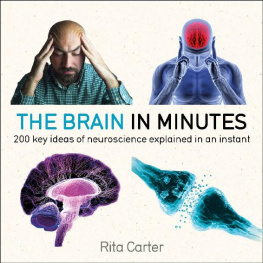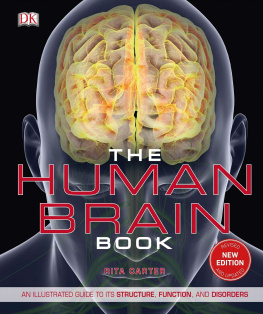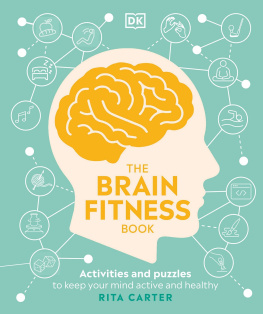Rita Carter - The brain in minutes
Here you can read online Rita Carter - The brain in minutes full text of the book (entire story) in english for free. Download pdf and epub, get meaning, cover and reviews about this ebook. year: 2018, genre: Romance novel. Description of the work, (preface) as well as reviews are available. Best literature library LitArk.com created for fans of good reading and offers a wide selection of genres:
Romance novel
Science fiction
Adventure
Detective
Science
History
Home and family
Prose
Art
Politics
Computer
Non-fiction
Religion
Business
Children
Humor
Choose a favorite category and find really read worthwhile books. Enjoy immersion in the world of imagination, feel the emotions of the characters or learn something new for yourself, make an fascinating discovery.
- Book:The brain in minutes
- Author:
- Genre:
- Year:2018
- Rating:3 / 5
- Favourites:Add to favourites
- Your mark:
- 60
- 1
- 2
- 3
- 4
- 5
The brain in minutes: summary, description and annotation
We offer to read an annotation, description, summary or preface (depends on what the author of the book "The brain in minutes" wrote himself). If you haven't found the necessary information about the book — write in the comments, we will try to find it.
The brain in minutes — read online for free the complete book (whole text) full work
Below is the text of the book, divided by pages. System saving the place of the last page read, allows you to conveniently read the book "The brain in minutes" online for free, without having to search again every time where you left off. Put a bookmark, and you can go to the page where you finished reading at any time.
Font size:
Interval:
Bookmark:
THE BRAIN IN MINUTES
RITA CARTER
THE BRAIN IN MINUTES
RITA CARTER
CONTENTS
Introduction
The human brain is the most complex object we know. Encapsulating around 100 trillion interconnections, it may be so complicated that it will never fully understand itself. Nonetheless, increasing numbers of scientists are attempting to penetrate the brains mysteries. Fifty years ago neuroscience was a barely recognized academic discipline while, today, twice as many neuroscience doctorates emerge yearly from universities as those in any other branch of science.
The neuroscientific revolution took off in the 1990s when new brain-imaging technology allowed researchers, for the first time, to look at a brain while it was working. Until then, the only brains that could be scrutinized were taken from the deceased.
The organs gross anatomy was well enough known; Freud was one of many dedicated scientists who dissected dead brains and painstakingly noted how they were built. The way
6 INTRODUCTION
it functioned, however, could only be deduced. Methods involved stimulating animal brains in various ways and seeing how the organisms responded, and noting odd behaviour in a person and, after their death, examining their brain for physical damage. Remarkable discoveries were made this way at the beginning of the 20th century, for example, Broca and Wernicke identified the language areas in the brain but it was slow work. Its often said that we now learn more about the brain each year than we knew in total before the millennium.
The deluge of brain research can make neuroscience a daunting subject. The ambition of this book, therefore, is to provide an introduction to the subject in a quick and readily understood way. Its broad scope offers an overarching perspective on the human brains efforts to comprehend itself, incorporating both historic discoveries and all the latest research.
I hope you will find it fascinating and surprising, and perhaps even a launchpad for further exploration of this strange and wonderful organ.
Rita Carter
INTRODUCTION 7
Origin of the brain
The earliest life forms were little bags of chemicals which perished easily. Some formed more robust colonies, keeping together by exchanging chemical signals. Some bound so tightly they became multicellular organisms. About 600 million years ago, electrical cells evolved an improvement on chemical signalling because they transmit information much faster. Now known as neurons, electrical cells formed systems which help the organisms adapt to changes in the environment. Primitive nervous systems are loose, distributed networks jellyfish, for instance, have sensory fibres that react to touch, light and chemicals, while linked motor neurons move the body in response. In more complex organisms, neurons clustered together for better communication. These neuronal bundles became the central nervous system (CNS), the forward part of which is the brain. The more densely interconnected an animals CNS, the more complicated its reactions. The human brain takes in millions of signals every second, causing its owner to behave in ways that range from brilliant to baffling.
8 EVOLUTION AND DEVELOPMENT OF THE BRAIN
Nerve net
Primitive brain
Primitive brain
Nerve cord with ganglia
Nerve cords
Jellyfish Flatworm
Earthworm
Forebrain
Forebrain Forebrain
Fish
Goose
Human
Nervous systems with centralized processing units evolved from more dispersed neural networks, such as those of jellyfish. In higher animals, the forebrain dominates.
Triune brain
The human brain can be thought of as three brains stacked one on top of the other. The bottom one is the reptilian brain, consisting of the brainstem and midbrain structures that control basic survival mechanisms. In the middle is the mammalian brain, broadly synonymous with the limbic system regions under the cortex (see page 58), and responsible for emotions. At the top sits the rational brain, comprising the cortex and frontal lobes. This triune structure was proposed in the 1960s by neuroanatomist Paul D MacLean. He thought it reflected the evolutionary history of our brains, from the purely reactive survival mechanism that dominates primitive animals, through to the conscious, thinking organ that is most fully evolved in humans. MacLeans model is popular and useful, but is misleading in many ways. For instance, all creatures with a central nervous system have three parts to their brain, albeit with differing proportions. And, although MacLeans divisions do act roughly as he says, they also fulfil a wide range of other functions.
10 EVOLUTION AND DEVELOPMENT OF THE BRAIN
Reptilian brain
Mammalian brain
Rational brain
Responsible for autopilot functions, the reptilian brain is the earliest structure in evolutionary terms. The mammalian brain confers emotions and memories, while the rational brain brings the ability to reason.
Ape to man
Human brains have evolved far beyond those of our primate ancestors, most obviously in size. They are three times larger than those of our nearest relatives, and almost ten times as many neurons are packed into the space between our ears. The massive number of potential interconnections allowed greatly enhanced brain power to emerge. Perhaps the most important evolutionary change, however, is the expansion of the frontal lobes, the seat of higher cognitive functions, such as thinking, judging and planning. Enlarged temporal lobes and the cerebellum also had a role in the development of language.
The reasons for this transformation in our evolutionary history is unknown. It might have begun with a chance genetic mutation. Or more likely it may have been caused by a complex intermixture of social and physical changes, including the pressures of group living, the nutrient benefit of meat-eating, the necessary adaptions that came from standing upright and the switch from eating leaves to fruit.
12 EVOLUTION AND DEVELOPMENT OF THE BRAIN
Comparative size of human and chimpanzee brains
Despite the differences in size, chimpanzee brains have a similar proportion of cerebral cortex. Our abilities may be down to our brains stronger and more richly interconnected substructure.
Human brain
Chimpanzee brain
Human versus animal brains
All brains of vertebrate animals are similar in that they are made up of three parts (see page 10), which fulfil broadly the same functions in all species. However, the size, structure, interactions and interconnections of these areas vary greatly from one animal to another.
In general, brains get bigger as the size of the animal increases. Hence, the largest brains about 7.8 kg (17 lb) are found in sperm whales. Elephants come second, averaging 4.8 kg (10.6 lb). This compares with about 1.4 kg (3 lb) for the average human brain. Size is not a very good indicator of intelligence, though. The ratio of brainweight to bodyweight is a little better. In humans, this ratio is about 1:50, compared with a hippos 1:2700. Even so, this measure does throw up strange results, such as ants with a ratio of just 1:7. Perhaps the most distinctive things about the human brain, compared to those of other animals, are the relatively large frontal lobes, and the complexity and greater size of the cortex.
14 EVOLUTION AND DEVELOPMENT OF THE BRAIN
Comparative brain sizes of mammals
Elephant
Human
Dog
Gorilla
Cat
Mouse
Dolphin
Macaque
Genes
A gene is a short sequence of DNA, the iconic double-spiral molecule curled up in your cells. Scientists have only recently begun to tease out the contribution of genetics to a persons behaviour and personality. Humans have about 20,000 genes, of which around 1,500 are concerned with building the brain. Research has focused mainly on gene polymorphisms different versions of the same gene. One variant of a gene called CADM2, for example, seems to promote risk-taking, while a variation of the VMAT2 gene predisposes people to spiritual or religious beliefs, and one type of MAO gene is known popularly as the warrior gene because of its association with aggression. Few, if any, gene mutations are solely responsible for behaviour, since most of the development of the human brain occurs after birth. Nurture may cancel out, or amplify, the effect of a particular gene variant. For instance, the reckless aggression associated with the MAO variation seems to manifest only if a person has experienced childhood abuse or drinks heavily. In others, it may create positive risk-taking and leadership qualities.
Next pageFont size:
Interval:
Bookmark:
Similar books «The brain in minutes»
Look at similar books to The brain in minutes. We have selected literature similar in name and meaning in the hope of providing readers with more options to find new, interesting, not yet read works.
Discussion, reviews of the book The brain in minutes and just readers' own opinions. Leave your comments, write what you think about the work, its meaning or the main characters. Specify what exactly you liked and what you didn't like, and why you think so.











